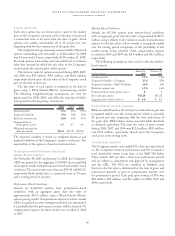American Express 2008 Annual Report Download - page 97
Download and view the complete annual report
Please find page 97 of the 2008 American Express annual report below. You can navigate through the pages in the report by either clicking on the pages listed below, or by using the keyword search tool below to find specific information within the annual report.
notes to consolidated financial statements
american express company
95
note 11
other liabilities
The following is a summary of other liabilities at December 31:
(Millions) 2008 2007
Membership Rewards liabilities $ 4,643 $ 4,785
Employee-related liabilities(a) 2,026 1,887
Deferred charge card fees, net 1,041 1,030
Other(b) 6,882 6,105
Total $14,592 $13,807
(a) Employee-related liabilities include employee benefit plan obligations and
incentive compensation.
(b) Other includes accruals for rebates, advertising and promotion, derivatives,
restructuring and reengineering reserves, and minority interest in
subsidiaries.
deferred charge card fees
The carrying amount of deferred charge card and other fees,
net of direct acquisition costs and reserves for membership
cancellations as of December 31 were as follows:
(Millions) 2008 2007
Deferred charge card and other fees $1,233 $1,211
Deferred direct acquisition costs (78) (79)
Reserves for membership cancellations (114) (102)
Deferred charge card fees and other, net of
direct acquisition costs and reserves $1,041 $1,030
note 12
common and preferred
shares
At December 31, 2008, the Company has 100 million common
shares remaining under the share repurchase authorizations.
Such authorizations do not have an expiration date, and at
present, there is no intention to modify or otherwise rescind
the current authorizations.
Common shares are retired by the Company upon repurchase
(except for 372,383 and 500,000 shares held as treasury shares
at December 31, 2008 and 2007, respectively), and excluded
from the shares outstanding in the table below. There were no
shares held in treasury as of December 31, 2006.
The following table shows authorized shares and provides a
reconciliation of common shares issued and outstanding:
(Millions, except where indicated) 2008 2007 2006
Common shares authorized (billions)(a) 3.6 3.6 3.6
Shares issued and outstanding at
beginning of year 1,158 1,199 1,241
Repurchases of common shares (5) (60) (75)
Acquisition of Harbor Payments —— 2
Other, primarily stock option exercises 719 31
Shares issued and outstanding at end
of year 1,160 1,158 1,199
(a) Of the common shares authorized but unissued at December 31, 2008,
approximately 143 million shares were reserved for issuance for employee
stock, employee benefit and dividend reinvestment plans.
The Board of Directors is authorized to permit the Company
to issue up to 20 million preferred shares at a par value of $1.66
2/3 without further shareholder approval. At December 31, 2008
and 2007, no preferred shares had been issued.
On January 9, 2009, the Company participated in the United
States Department of Treasury’s Capital Purchase Program
(CPP), and issued 3,388,890 shares of the Company’s Fixed
Rate Cumulative Perpetual Preferred Stock, Series A, to the
Treasury Department. Refer to Note 27 for further discussion.
note 13
regulatory matters and
capital adequacy
As previously discussed, the Company became a bank holding
company under the Bank Holding Company Act of 1956
during the fourth quarter of 2008. At that time, the Federal
Reserve became the Company’s primary federal regulator
and the Company became subject to the Federal Reserve’s
requirements for risk-based capital and leverage ratios.
The Federal Reserve’s guidelines for capital adequacy define
two categories of risk-based capital: Tier 1 capital and Tier 2
capital. Tier 1 capital, as it applies to the Company, is comprised
of shareholders’ equity less goodwill and other adjustments. Tier
2 capital, as it applies to the Company, consists of the aggregate
allowance for credit losses up to a certain percentage of risk-
weighted assets, and a portion of any unrealized gains of equity
securities. Under the risk-based capital guidelines of the Federal
Reserve, the Company is required to maintain minimum ratios
of Tier 1 and Total (Tier 1 plus Tier 2) capital to risk weighted
assets, as well as minimum leverage ratios (which are defined
as Tier 1 capital to average adjusted on-balance sheets assets).
Failure to meet these minimum requirements could cause the
Federal Reserve Board to take action.
























